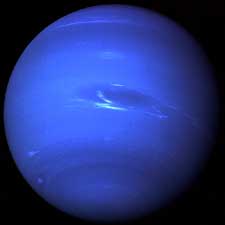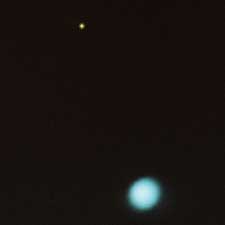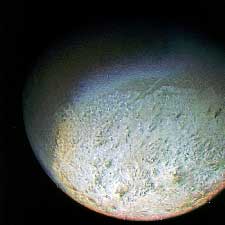Neptune
Neptune is the eighth planet furthest away from the Sun and is the final planet in our solar system.
Previously, Pluto was considered as the ninth and final planet but Pluto is no longer considered a planet – it is now classed as a dwarf planet. Neptune is the last of the gas giant planets and share many characteristics with its near twin planet Uranus.
Neptune is 17 times the mass of Earth (compared with Uranus which is 15 times the mass of Earth), and is composed mainly of hydrogen and helium, with some traces of other hydrocarbons. Neptune is often referred to as an “ice giant”. This is because it contains a high level of icy material such as water, ammonia, and methane. The methane is the gas that gives the planet a similar blue colour to its neighbour planet Uranus.
How was Neptune discovered?
It is not possible to see Neptune with the naked eye. It would take a powerful telescope to be able to view the planet, so how was Neptune first discovered?
Interestingly, it was not discovered by chance by scanning the sky with a telescope as is the case with many astronomical discoveries, it was actually discovered through advanced mathematics. The French mathematician Urbain Joseph Le Verrier predicted that a planet would exist in a particular part of the sky because he had observed an unusual pattern in the orbit of Uranus that he thought could be due to the gravitational pull of another planet.
He sent his findings to the astronomer Johann Gottfried Galle at the Berlin observatory and asked that he search the sky in his predicted position for evidence of a new planet.
Amazingly, the calculations proved to be correct and in 1846 Neptune was discovered at the Berlin observatory by telescope and named Neptune after the Roman god of the sea.
Neptune Facts
Neptune was the last of the planets in our solar system to be discovered. Technically it was discovered in 1846, but it was postulated by a mathematician that it existed a year earlier through complex calculations. It was only when a telescope was trained on the specific area that the calculations denoted that they planet was seen.
Neptune is the eighth and furthest planet from the Sun in our solar system. The average orbital distance from the Sun is 4.5 billion kilometres away.
An Earth day would take 16 hours to complete on Neptune.
Neptune completes a full orbit of the Sun once every 165 Earth years. The first full orbit was recorded in 2011 because the planet was only discovered by us in 1846.
Neptune is the fourth largest planet by diameter (49,244 km) and the third largest by mass (17 times the mass of the Earth.
Neptune has 14 known moons. The largest by far is Triton which amounts to 99.5% of the mass which orbits the planet. Triton has a retrograde orbit which leads scientists to believe that it is not a native moon to Neptune, rather it has been captured by Neptune at some point in history and it is now stuck in orbit. Triton may originally have been a dwarf planet that was from the Kuiper belt.
William Lassell discovered Triton just 17 days after Neptune was discovered.
Voyager 2 first discovered a number of Neptune’s moons during its flyby in 1989, these being Nereid, Proteus, Naiad, Thalassa, Despina and Galatea.
The moon Triton has the lowest recorded temperature of any object in the solar system to date at -235 degrees Celsius.
Neptune is smaller than its twin planet Uranus, but it has a greater mass than Uranus.
The methane in the atmosphere absorbing red light is what gives the planet a pleasant blue colour.
Neptune is home to severe weather systems. During the Voyager 2 mission a massive storm was observed which led to the name the Great Dark Spot. This storm was around 13,000 km wide.
Neptune has a faint ring system in place. It is believed that there are 6 rings which contain ice and/or carbon based materials.
It is believed that Neptune has the strongest winds of any planet in the solar system, with gusts of over 2,000km/h possible.
Neptune is the coldest planet in our solar system. Temperatures are as low as -221 degrees Celsius.
Neptune’s atmosphere is made up of roughly 80% hydrogen and 19% helium, with trace amounts of methane.
Figures and Statistics
| Neptune | Earth | Ratio (Planet to Earth) | |
| Rotation period - (hours) | 16.11 | 23.9345 | 0.673 |
| Length of day - (hours) | 16.11 | 24.00 | 0.671 |
| Length of year (earth days) | 60225 | 365 | 165 |
| One complete orbit takes (earth days) | 60190 | 365.256 | 164.789 |
| Radius (km) | 24764 | 6378.1 | 3.883 |
| Mass (1024 kg) | 102.42 | 5.9726 | 17.147 |
| Volume (1010 km3) | 6254 | 108.321 | 57.74 |
| Density (kg/m3) | 1638 | 5514 | 0.297 |
| Distance from Earth - Min (106km) | 4305.9 | - | - |
| Distance from Earth - Max - (106km) | 4687.3 | - | - |
| Average distance from Sun (106km) | 4495.06 | 149.6 | 30.047 |
| Orbital radius (106km) | 4444-4546 | 147-152 | 30.2 - 29.9 |
| Orbital velocity (average - km/s) | 5.43 | 29.78 | 0.182 |
| Rotational velocity (km/h) | 9660 | 1674.4 | 5.769 |
| Surface gravity (m/s2) | 11.15 | 9.81 | 1.14 |
| Surface temp - Average (K) | 72 | 184 | 0.391 |
| Axial tilt (degrees) | 28.32 | 23.44 | 1.208 |
| Number of natural satellites (moons) | 14 | 1 | 14 |
-
Notes on the above figures:
- Orbits are invariably elliptical in nature. The average distance from the sun that appears above is also known as a 'semi-major axis', which is the mean (average) radius of the elliptical orbit.
- Axial tilt is also known as 'obliquity to orbit' and is the angle of rotation of the body itself with an imaginary line drawn through both poles, relative to its plane of orbit.
- Radius figures quoted are equatorial measurements. As most bodies exhibit 'oblateness' - that is to say that they appear slightly squashed - the radius from the centre to the poles would invariably be shorter.
- The Kelvin temperature scale is used for all temperature measurements above. 0K is equivalent to -273.15°C (degrees Celsius). To convert from K to C, simply subtract this figure from the Kelvin temperature given.
- Use of 'Index Notation' for very large numbers as above can be explained as follows; 106 = 10 x 10 x 10 x 10 x 10 x 10, or 1,000,000. For example, if you see a number that appears as 6x1011 then that number written in full would be 6 x 10 x 10 x 10 x 10 x 10 x 10 x 10 x 10 x 10 x 10 x 10 - or 600,000,000,000. Index notation allows us to write very big (or very small) numbers down far more concisely.


